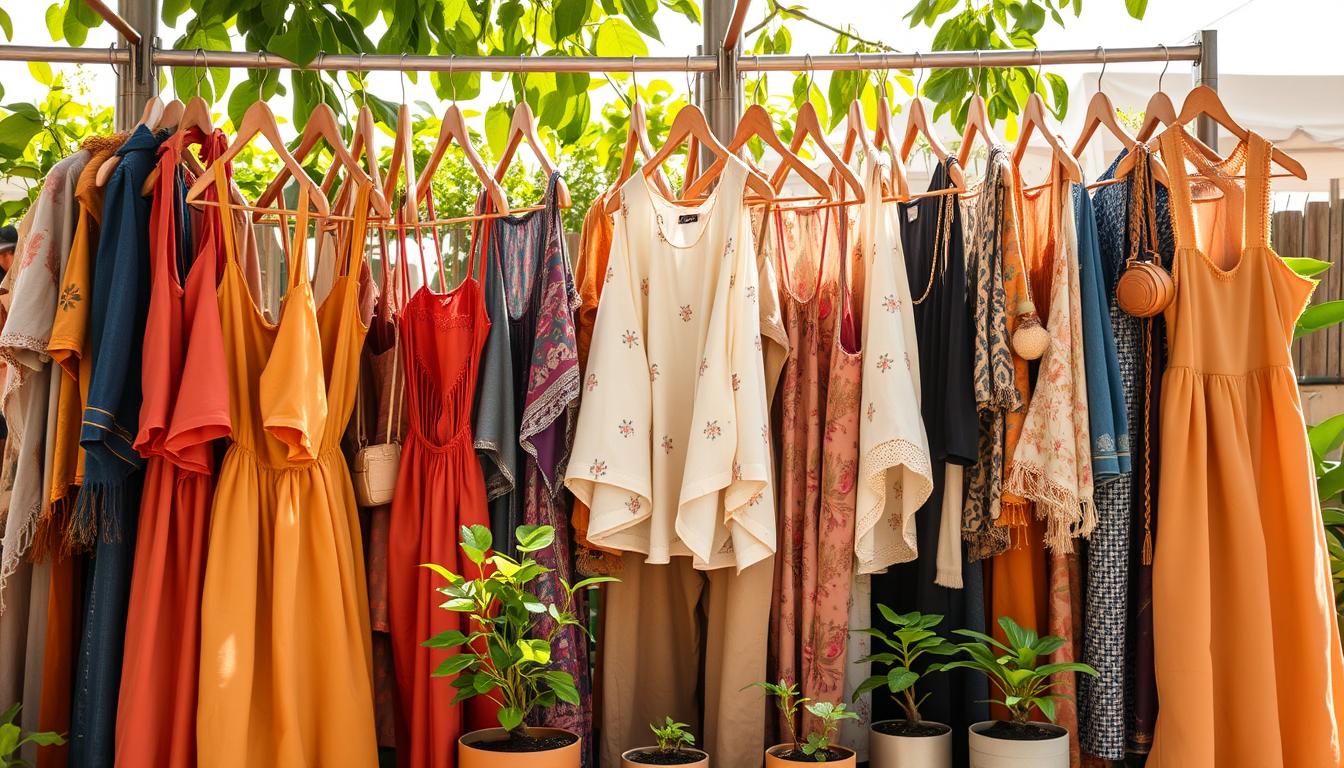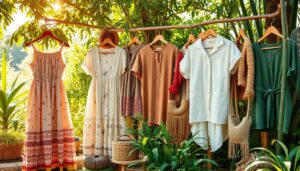Every time I open my closet, I feel a mix of excitement and guilt. The thrill of finding a great outfit meets the guilt of how it affects the environment. I’ve learned that choosing ethical clothes is crucial for our planet and future.
By going for sustainable style, we can change our wardrobes. They become a mix of our personal taste and our care for the earth. Every choice to pick eco-friendly fashion over fast fashion is a step towards change.
Key Takeaways
- Understanding eco-friendly fashion enhances personal responsibility.
- Choosing sustainable clothing impacts the environment positively.
- Ethical clothing choices can be stylish and chic.
- Every individual can contribute to a healthier planet through their wardrobe.
- Investing in quality over quantity fosters sustainability.
Understanding Eco-friendly Fashion
Eco-friendly fashion is a movement that focuses on making clothes in a sustainable way. It’s about combining style with caring for the planet. This means using recycled materials and green manufacturing methods.
When I choose eco-friendly clothes, I help reduce the harm caused by making clothes. This choice makes our planet a bit healthier. It also makes me think more about what I buy, affecting the fashion world.
By living eco-friendly, I make a difference. I support a future where fashion and caring for the earth go together. It’s a way to make a positive impact every day.
The Importance of Sustainable Style

Choosing sustainable style is crucial for our planet and society. The fast fashion industry harms the environment and exploits workers. Sustainable fashion advice helps us make better choices.
Wearing clothes made from organic or recycled materials helps reduce our carbon footprint. This choice fights against the negative effects of traditional fashion. It also supports companies that treat workers fairly and use eco-friendly methods.
Our fashion choices affect more than just our style. By supporting sustainable brands, we help create a better fashion world. This effort can make a big difference for our planet and society.
| Impact of Fast Fashion | Sustainable Alternatives |
|---|---|
| High levels of pollution from waste and textile production | Use of organic fabrics that minimize environmental damage |
| Excessive waste in landfills | Emphasis on recycling and upcycling in design |
| Exploitation of workers in developing countries | Support of local artisans and fair trade companies |
| Promotion of a disposable culture in fashion | Focus on timeless designs that promote longevity |
Adopting sustainable style has made me feel more connected to my clothes. This journey shows me the impact we can have on fashion’s future.
Eco-friendly Fashion Tips
Adding eco-friendly habits to my wardrobe boosts my style and commitment to the planet. Here are some tips that fit with green fashion, sustainable fashion, and ethical clothes.
Choosing Natural Fabrics
Choosing natural materials is a great way to support sustainable fashion. Fabrics like organic cotton, hemp, and Tencel are kind to the earth. They’re grown without harmful chemicals, making them better for the planet and my skin.
Avoiding Fast Fashion
Fast fashion might seem cheap, but it’s costly in many ways. I prefer buying quality, timeless pieces. This choice helps reduce waste and supports a better clothing economy.
Supporting Ethical Brands
Looking for brands that treat workers fairly changes how I shop. I look for companies that are open about how they make their clothes and pay workers fairly. By picking these brands, I help make fashion more sustainable and encourage smart shopping.
Building an Environmentally Conscious Wardrobe
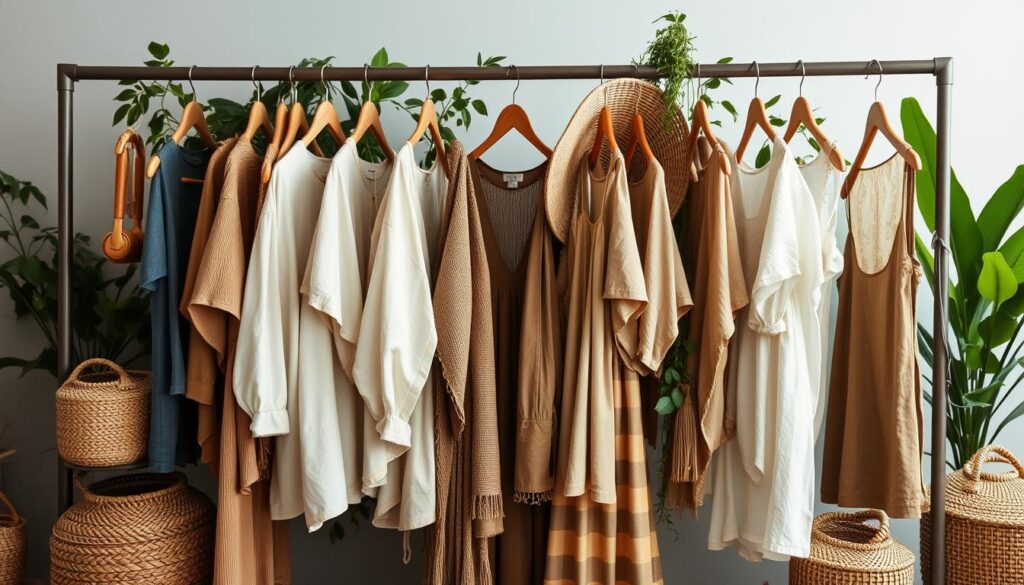
Creating an environmentally conscious wardrobe is a rewarding journey. It lets me choose sustainable fashion. The first step is to look at what I already own. I figure out which clothes I wear often and which ones I don’t.
Decluttering is key in this process. I give away or recycle clothes that are still in good shape. This way, they get a second life instead of ending up in landfills. Places like Goodwill or recycling programs are great for this.
Adding clothes made ethically is important too. I look for brands that care about the planet and fair labor. Companies like Patagonia, Reformation, and Everlane are good choices. They show me that fashion can be both stylish and sustainable.
My goal is to value quality over quantity. Buying fewer, better-made items helps me avoid waste. It also means I get to enjoy clothes that truly reflect my values.
| Brand | Practices | Materials Used |
|---|---|---|
| Patagonia | Fair Trade Certified, Donates 1% to the Planet | Recycled polyester, Organic cotton |
| Reformation | Sustainable sourcing, Transparency in the supply chain | Eco-friendly fabrics, Tencel |
| Everlane | Radical Transparency, Ethical factories | Cashmere, Organic cotton |
Mastering Green Style Suggestions
Accessorizing sustainably can really boost my green style. The right pieces let me show my unique style while helping the planet. I choose accessories made from eco-friendly materials or by ethical brands. This fits well with my eco-friendly wardrobe tips.
Accessorizing with Sustainability
Thinking about sustainable accessories, I find many options that match my green goals. Here are some key points to remember:
- Choose eco-friendly fabrics: Bags made from organic cotton or recycled materials are great. Reformation offers stylish, planet-friendly options.
- Invest in ethically made shoes: Look for shoes from companies that treat workers fairly. Allbirds uses renewable resources, offering both comfort and sustainability.
- Seek out sustainable jewelry: Pieces made from recycled metals or ethically sourced stones are good choices. Sarah H.’s collection focuses on responsible craftsmanship.
Minimalism is key in my accessorizing. Choosing fewer, well-designed pieces keeps my look simple and stylish. This approach also supports sustainable living. Each accessory tells a story, showing my commitment to eco-friendly fashion.
Mixing and Matching for Sustainable Fashion
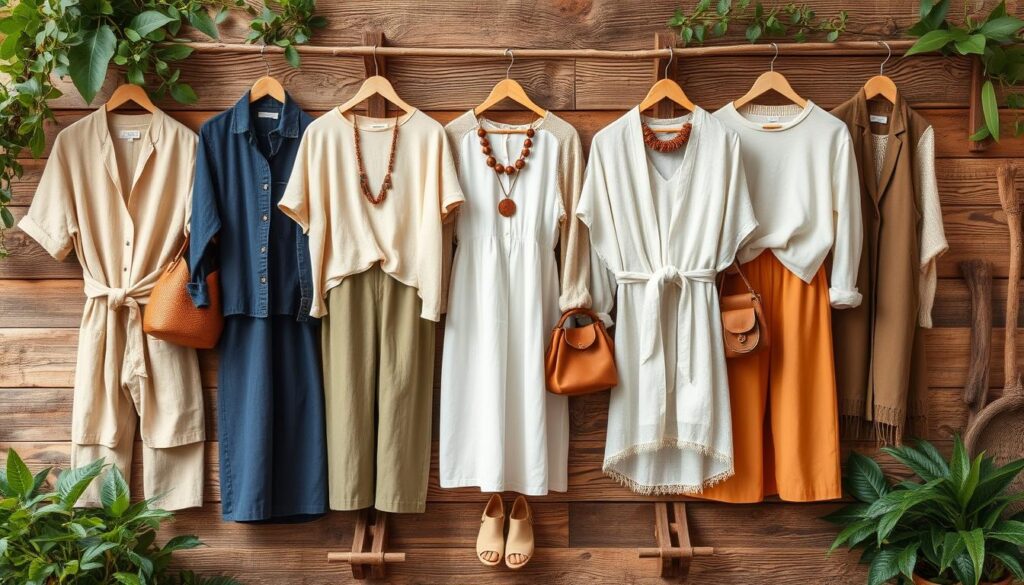
Mixing and matching can turn my wardrobe into a treasure trove of unique outfits. By combining different pieces, I can create many outfits without buying new clothes. This saves money and supports eco-friendly choices.
Learning the basics of mixing and matching helps reduce waste. Some key strategies include:
- Opt for Versatile Basics: Classic items like white tees, denim jeans, and simple dresses work well with almost anything.
- Play with Layers: Using cardigans or jackets over different tops offers fresh looks while maximizing warmth.
- Accessorize Thoughtfully: Accessories can elevate any outfit. I often enhance my looks with handmade jewelry or upcycled bags.
Color coordination is also crucial. Using a cohesive color palette makes mixing and matching easier. I focus on neutral shades with occasional bold colors, adding a lively yet sophisticated touch to my outfits.
| Outfit Base | Styling Elements | Complete Look |
|---|---|---|
| White Tee | Denim Jacket, Green Scarf | Casual and Trendy |
| Little Black Dress | Chunky Necklace, Ankle Boots | Chic Evening Wear |
| Maxi Skirt | Graphic Tee, Jean Jacket | Boho Casual |
These green living fashion tips let me be creative while staying true to sustainability. Each outfit I make shows off my style and how simple choices can help the environment.
Exploring Eco-conscious Fashion Trends
My journey into eco-friendly fashion shows how creativity meets sustainability. Upcycling is big now, turning old clothes into new, stylish items. It cuts down on waste and brings out unique styles with a story.
Second-hand shopping is also on the rise. Stores like ThredUp and Poshmark have lots of pre-loved items. This makes sustainable fashion easy to find and fun to shop for.
Brands like Reformation and Patagonia lead the way. They use recycled materials and are open about their practices. This lets us know our clothes are made with care and honesty.
- Upcycling: Transforming old clothes into new creations.
- Second-hand shopping: Finding unique pieces while promoting sustainability.
- Reclaimed materials: Brands utilizing salvaged fabrics for new fashion lines.
Exploring eco-friendly trends shows us the value of knowing where our clothes come from. People looking for sustainable fashion are making brands more accountable. This effort is building a better future for all of us.
| Trend | Description | Benefits |
|---|---|---|
| Upcycling | Redesigning existing garments. | Reduces waste, promotes creativity. |
| Second-hand Shopping | Buying pre-loved clothing. | Encourages sustainable consumption, saves money. |
| Reclaimed Fabrics | Using fabrics that were previously discarded. | Minimizes environmental impact, unique designs. |
Green Living Fashion Tips for Everyday Wear
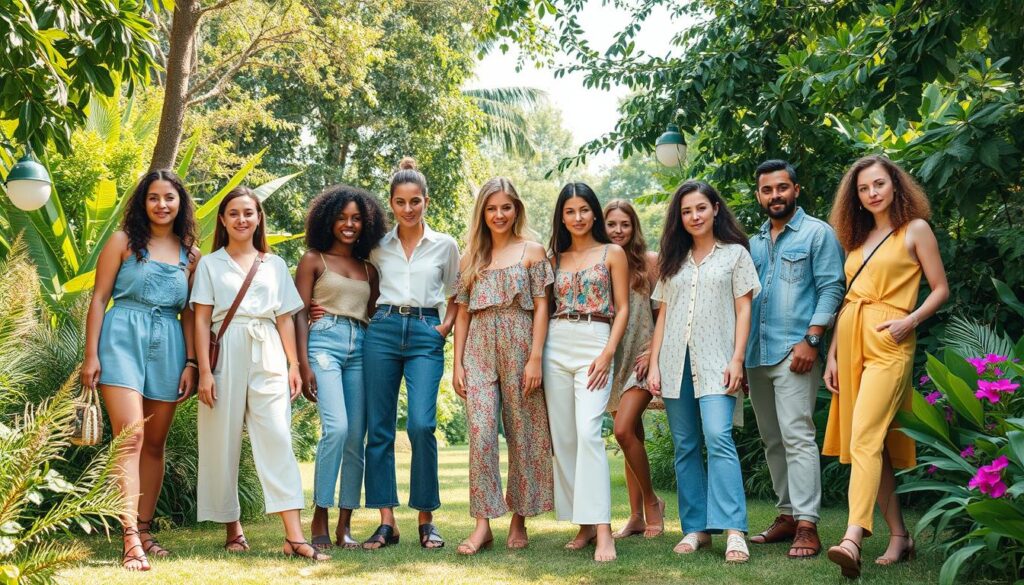
Making your daily wear more sustainable is easy. Just a few simple changes can make a big difference. Here are some green living fashion tips that I find really helpful.
Begin with laundry care. Using eco-friendly detergents helps the environment and keeps your clothes in better shape. Instead of using a dryer, try air-drying your clothes. This saves energy and makes your clothes last longer.
Looking after your clothes is key to being sustainable. Catching small problems early can stop you from needing to buy new clothes. I mend small tears and reinforce seams instead of throwing things away. This saves money and helps the planet.
Building sustainable fashion habits is important, especially in today’s fast world. Spending a bit more on quality items can save you money in the long run. When I buy clothes, I look for pieces that are versatile and durable. This supports eco-conscious fashion tips.
- Choose eco-friendly detergents.
- Air-dry clothes whenever possible.
- Repair clothing instead of throwing it away.
- Invest in quality pieces that last longer.
Small changes in our habits can make a big difference. Every choice we make helps us live more sustainably. By following eco-conscious fashion tips, we can look good and do good for the planet.
| Practice | Benefits |
|---|---|
| Using eco-friendly detergents | Reduces chemical exposure and environmental harm |
| Air-drying garments | Conserves energy and protects fabrics |
| Repairing clothes | Extends clothing lifespan and reduces waste |
| Investing in quality | Ensures durability and value over time |
Strategies for Conscious Consumer Fashion
Becoming a conscious consumer in fashion takes effort and awareness. I start by looking for red flags in fast fashion brands. Low prices and quick inventory changes often mean sustainability issues. Spotting these signs helps avoid brands that care more about profit than ethics.
It’s key to research where products come from. Learning about material origins and production methods is enlightening. Brands that share their supply chain details show they value conscious fashion.
Knowing about certifications like Fair Trade and GOTS is also important. These labels mean ethical practices were used in making the product. When shopping, I look for these certifications to ensure a brand’s commitment to sustainable fashion.
Here are some practical ways to start this journey:
- Investigate brands before buying. Seek information about their environmental policies and labor practices.
- Consider second-hand options. Vintage and thrift shopping promotes recycling and reduces waste.
- Invest in quality pieces that stand the test of time rather than chasing fleeting trends.
- Support local businesses that prioritize sustainability.
Creating a Capsule Wardrobe

Building a capsule wardrobe is key to sustainable fashion. It’s about picking a few, versatile pieces that last long. This way, you can be creative without wasting money or resources.
Selecting Timeless Pieces
I look for classic styles that never go out of fashion. A good blazer, a little black dress, and quality denim are must-haves. They can be worn in many ways, making your wardrobe versatile.
- Classic white button-up shirt
- Versatile black trousers
- Elegant midi dress
- Neutral-colored cardigan
- Comfortable ankle boots
Quality over Quantity in Fashion
Buying high-quality clothes is better for the planet. Spending a bit more on durable items means less waste. Plus, it encourages us to buy less.
| Aspect | Quality Items | Fast Fashion |
|---|---|---|
| Longevity | Years of wear | Often discarded after a few wears |
| Material | Natural fibers | Synthetic materials |
| Environmental Impact | Lower, supports sustainability | Higher, contributes to pollution |
Conclusion
Exploring eco-friendly fashion tips shows us that sustainable style is more than a trend. It’s a crucial step towards a better way of living. Every choice we make in fashion affects the environment. Small changes add up to make a big difference.
Choosing natural fabrics and supporting ethical brands is key. These actions help create a more sustainable future. It’s all about making conscious decisions in our fashion choices.
Adding eco-friendly fashion tips to our daily lives is doable and fulfilling. By choosing quality over fast fashion, we can build a wardrobe that shows our values. This way, we can make fashion more sustainable and responsible.
My journey in eco-friendly fashion is ongoing. I encourage you to join me. Let’s make choices that support sustainable fashion. Together, we can make a positive impact on our planet through fashion.
FAQ
What is eco-friendly fashion?
Eco-friendly fashion means clothes and accessories made in ways that protect the planet. It uses recycled materials and sustainable manufacturing. It also aims to cut down on the carbon footprint of making clothes.
Why should I choose sustainable style?
Sustainable style fights against the bad effects of fast fashion. This includes pollution, waste, and unfair labor practices. By choosing ethical clothes, you help make the fashion world better for everyone and the planet.
How can I create an environmentally conscious wardrobe?
Start by looking at your clothes and getting rid of what you don’t need. Then, add items that are made in a way that’s good for the planet. Choose quality over quantity to make your wardrobe more sustainable.
What are some eco-friendly fashion tips I can follow?
To dress eco-friendly, pick natural fabrics like organic cotton. Avoid cheap, fast fashion and go for durable items. Also, support brands that make clothes in a way that’s kind to the environment.
What are green style suggestions for accessories?
For accessories, look for bags, shoes, and jewelry made from eco-friendly materials. Choose a few, simple pieces that go well with many outfits. This way, you can add to your sustainable style without overdoing it.
How can I mix and match my clothing sustainably?
Mix and match by using a few key pieces in different ways. This creates many outfits and reduces the need to buy more. It’s a creative way to follow sustainable fashion.
Are there current eco-friendly fashion trends I should know about?
Yes! Today, trends include upcycling, second-hand shopping, and using old materials in new ways. These trends help make fashion more sustainable and open.
What are some green living fashion tips for everyday wear?
For everyday, focus on how you care for your clothes. Air-dry them and use green laundry detergent. Small changes can make a big difference for the planet.
How can I become a conscious consumer when it comes to fashion?
To be a conscious consumer, watch out for signs of bad fashion brands. Learn about where your clothes come from and look for Fair Trade and GOTS labels. Making informed choices helps push for better fashion practices.
What is a capsule wardrobe and how can I create one?
A capsule wardrobe is a small set of clothes that can be mixed and matched. Choose timeless pieces and focus on quality over quantity. This reduces waste and supports sustainable fashion.

